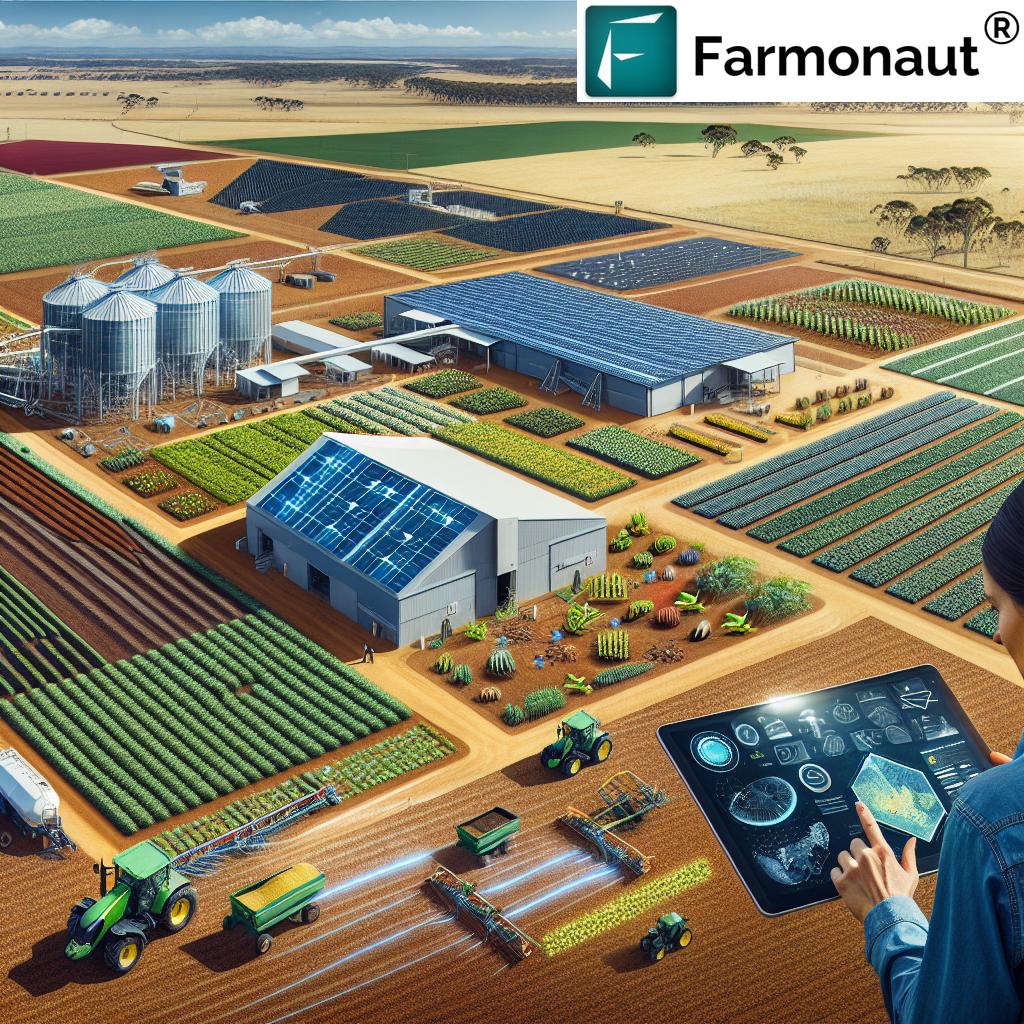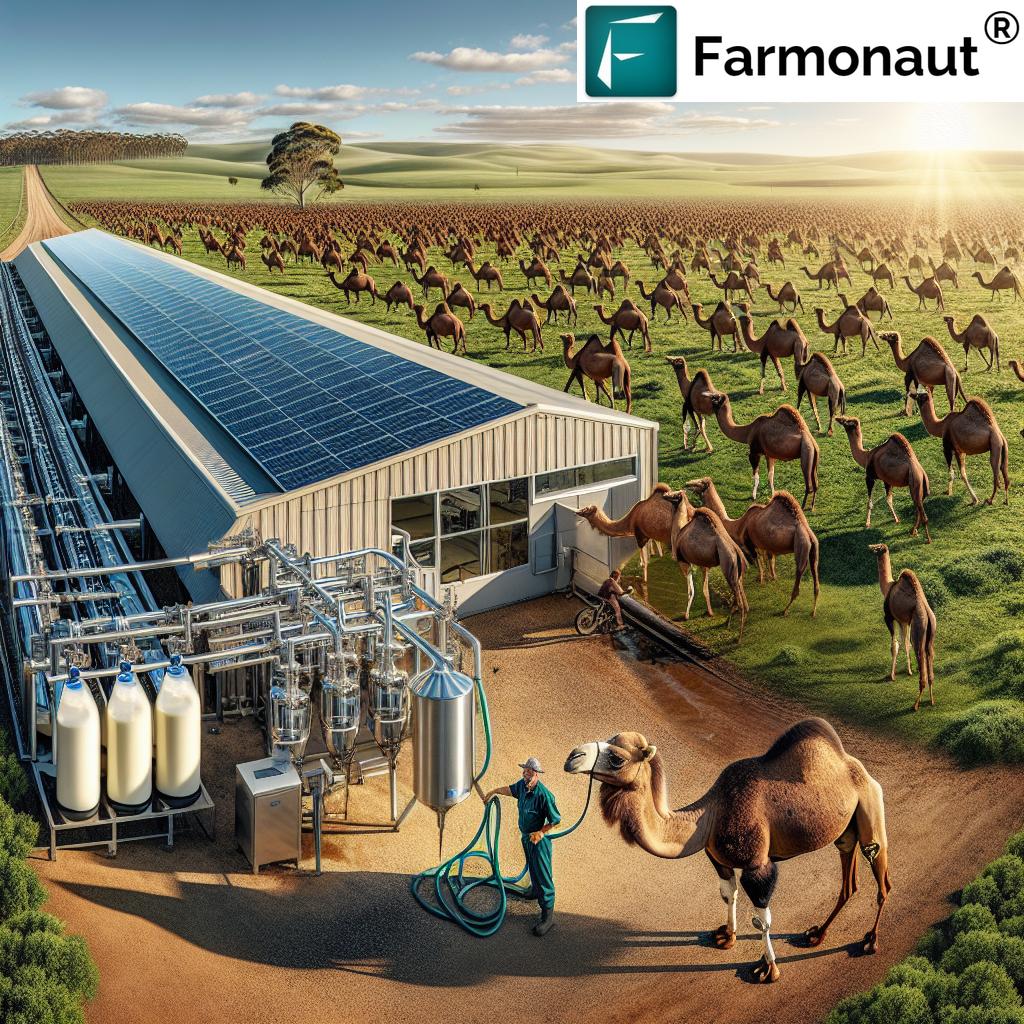Sustainable Grain Farming: Australian Growers’ Guide to Profitable and Environmentally Responsible Agriculture
“Australian grain farmers have reduced their carbon footprint by 35% over the past decade through sustainable practices.”
In the vast landscapes of Australia, where golden fields stretch as far as the eye can see, a revolution is taking place. We, as representatives of the agricultural community, are witnessing a significant shift towards sustainable grain farming practices that promise both profitability and environmental stewardship. This comprehensive guide delves into the heart of the Australian grain industry, exploring the challenges, innovations, and strategies that are shaping the future of our rural agricultural development.

The State of Australian Grain Farming: An Annual Report Analysis
The latest annual grain industry report paints a picture of resilience and innovation. Australian grain farmers have consistently demonstrated their ability to adapt to changing conditions, from climate variability to market fluctuations. The report highlights several key areas that are crucial for understanding the current state and future direction of our industry:
- Production Trends: Despite challenges, grain production has shown steady growth, with wheat, barley, and canola leading the charge.
- Economic Impact: The grain industry continues to be a significant contributor to the Australian economy, with exports playing a vital role.
- Sustainability Metrics: There’s a clear trend towards more sustainable practices, with a focus on reducing water usage and carbon emissions.
- Technological Adoption: Farmers are increasingly embracing precision agriculture technologies to optimize their operations.
To gain deeper insights into how technology is revolutionizing sustainable farming practices, let’s take a look at this informative video:
As we can see, innovative solutions like those offered by Farmonaut are playing a crucial role in advancing sustainable farming practices. Their satellite-based technology provides farmers with valuable insights for more efficient land use and resource management.
Challenges Facing the Australian Grain Industry
While the industry shows promise, it’s not without its challenges. Understanding these hurdles is crucial for developing effective strategies to overcome them:
- Climate Variability: Unpredictable weather patterns and extreme events pose significant risks to crop yields.
- Market Volatility: Fluctuating global grain prices can impact farm profitability.
- Resource Management: Balancing water usage and soil health remains a constant challenge.
- Pest and Disease Management: Evolving threats require innovative approaches to crop protection.
- Infrastructure and Logistics: Efficient transportation and storage of grain continue to be areas of concern.
To address these challenges, the industry is focusing on several key areas of development and innovation.
Innovations Driving Sustainable Grain Production
The Australian grain industry is at the forefront of adopting innovative technologies and practices to enhance sustainability and profitability. Here are some of the most promising developments:
- Precision Agriculture: Utilizing GPS-guided machinery and satellite imagery for optimal resource allocation.
- Drought-Resistant Crop Varieties: Developing grain varieties that can thrive in water-stressed conditions.
- Integrated Pest Management: Implementing biological control methods to reduce reliance on chemical pesticides.
- Soil Health Initiatives: Promoting practices like cover cropping and reduced tillage to improve soil structure and fertility.
- Smart Irrigation Systems: Deploying sensors and AI-driven algorithms to optimize water usage.
One of the most exciting advancements in this field is the use of satellite technology for farm management. Farmonaut’s API offers farmers access to real-time satellite data, enabling them to make informed decisions about crop health, irrigation, and resource allocation.

Agricultural Policy Advocacy: Shaping the Future of Farming
Policy plays a crucial role in supporting sustainable and profitable grain farming. Industry leaders and organizations are actively engaged in advocating for policies that promote:
- Research and Development Funding: Increased investment in agricultural research to drive innovation.
- Sustainable Farming Incentives: Programs that reward farmers for adopting environmentally friendly practices.
- Infrastructure Development: Improving rural roads, rail networks, and port facilities to enhance grain transportation efficiency.
- Market Access: Negotiating favorable trade agreements to expand export opportunities for Australian grain.
- Climate Change Adaptation: Supporting initiatives that help farmers adapt to changing climatic conditions.
These policy initiatives are crucial for creating an environment where sustainable grain farming can thrive. By aligning government support with industry needs, we can ensure a more resilient and prosperous future for Australian agriculture.
“The Australian grain industry contributes over $13 billion annually to the national economy while prioritizing environmental stewardship.”
Farm Sustainability Practices: A Closer Look
Implementing sustainable practices is at the heart of modern grain farming. Let’s explore some of the key strategies that Australian farmers are adopting to enhance their sustainability:
- Conservation Tillage: Minimizing soil disturbance to improve soil health and reduce erosion.
- Crop Rotation: Diversifying crop sequences to break pest cycles and improve soil fertility.
- Precision Nutrient Management: Using soil testing and variable-rate technology to optimize fertilizer application.
- Water-Efficient Irrigation: Implementing drip irrigation and moisture sensors to reduce water waste.
- Integrated Pest Management (IPM): Combining biological, cultural, and chemical controls to manage pests effectively.
To better understand the impact of these practices, let’s take a look at this comprehensive table of sustainability metrics:
| Grain Type | Water Usage (ML/hectare) | Carbon Footprint (kg CO2e/tonne) | Soil Health Index (0-100) | Biodiversity Score (0-10) | Profitability Index (0-100) |
|---|---|---|---|---|---|
| Wheat | 2.5 | 300 | 75 | 7 | 80 |
| Barley | 2.2 | 280 | 78 | 6 | 75 |
| Canola | 3.0 | 500 | 70 | 8 | 85 |
| Oats | 2.0 | 250 | 80 | 7 | 70 |
This data clearly shows the varying impacts of different grain types on sustainability metrics. It’s important to note that these figures can be significantly improved through the adoption of advanced farming techniques and technologies.
For instance, technologies like those offered by Farmonaut can help farmers monitor their crops’ health and optimize resource use. The Farmonaut Android app and iOS app provide easy access to these powerful tools right from a smartphone.
Rural Agricultural Development: Building Resilient Communities
Sustainable grain farming is not just about environmental stewardship; it’s also about fostering strong, resilient rural communities. Here are some initiatives that are making a difference:
- Education and Training Programs: Providing farmers with the knowledge and skills to implement sustainable practices.
- Rural Infrastructure Investment: Improving roads, internet connectivity, and healthcare facilities in farming communities.
- Diversification Support: Encouraging farmers to explore additional income streams, such as agritourism or value-added products.
- Mental Health Services: Recognizing the unique challenges faced by rural communities and providing support.
- Youth Engagement: Creating opportunities for young people to build careers in modern, technology-driven agriculture.
These initiatives are crucial for ensuring that rural communities can thrive alongside sustainable farming practices. By investing in our rural areas, we’re not just supporting farmers; we’re building the foundation for a stronger, more resilient agricultural sector.
The Role of Technology in Sustainable Grain Farming
Technology is playing an increasingly important role in driving sustainability and profitability in grain farming. Let’s explore some of the key technological advancements that are making a difference:
- Satellite Imagery and Remote Sensing: Providing real-time data on crop health, soil moisture, and potential issues.
- Artificial Intelligence and Machine Learning: Analyzing complex data sets to provide actionable insights for farm management.
- Internet of Things (IoT) Devices: Connecting farm equipment and sensors to optimize operations and resource use.
- Blockchain Technology: Enhancing traceability and transparency in the grain supply chain.
- Automated Machinery: Reducing labor costs and improving precision in planting, harvesting, and other farm operations.
One company at the forefront of this technological revolution is Farmonaut. Their innovative platform integrates satellite imagery, AI, and machine learning to provide farmers with valuable insights for sustainable farm management. To learn more about how Farmonaut is transforming agriculture, check out their API Developer Docs.
Addressing Critical Issues: Spray Drift Management and Freight Strategies
Two areas of particular concern for the Australian grain industry are spray drift management and freight strategies. Let’s examine these issues and the solutions being implemented:
Spray Drift Management
Spray drift can have significant environmental and economic impacts. The industry is addressing this through:
- Advanced Sprayer Technologies: Implementing precision sprayers with drift-reduction nozzles and automated control systems.
- Weather Monitoring: Using real-time weather data to determine optimal spraying conditions.
- Buffer Zones: Establishing and maintaining vegetative buffers to minimize drift to sensitive areas.
- Training and Education: Providing farmers and applicators with comprehensive training on best practices for spray application.
National Freight Strategy
Efficient transportation is crucial for the grain industry. The national freight strategy aims to:
- Improve Rail Infrastructure: Upgrading rail lines and increasing capacity to handle larger grain shipments.
- Enhance Port Facilities: Modernizing port infrastructure to expedite grain loading and reduce bottlenecks.
- Optimize Road Networks: Identifying and addressing key road transport corridors for grain movement.
- Implement Smart Logistics: Using AI and IoT technologies to optimize grain transportation routes and timing.
These strategies are essential for ensuring that Australian grain can be efficiently and cost-effectively transported from farm to market, both domestically and internationally.
The Future of Sustainable Grain Farming in Australia
As we look to the future, several key trends and initiatives are shaping the landscape of sustainable grain farming in Australia:
- Carbon Farming: Exploring opportunities for farmers to participate in carbon markets through sequestration practices.
- Regenerative Agriculture: Adopting holistic farming approaches that focus on soil health and ecosystem restoration.
- Precision Fermentation: Investigating the potential of lab-grown proteins and their impact on traditional grain markets.
- Climate-Resilient Crop Breeding: Developing new grain varieties that can thrive in changing climatic conditions.
- Agri-Food Tech Integration: Leveraging emerging technologies like robotics and nanotechnology in farming practices.
These developments promise to further enhance the sustainability and profitability of grain farming in Australia. By staying at the forefront of innovation, our industry can continue to thrive while meeting the growing global demand for food in an environmentally responsible manner.
Conclusion: A Sustainable and Profitable Future for Australian Grain Farming
As we’ve explored throughout this comprehensive guide, the Australian grain industry is at a pivotal point in its history. By embracing sustainable practices, leveraging cutting-edge technology, and advocating for supportive policies, we’re paving the way for a future where profitability and environmental stewardship go hand in hand.
The challenges we face are significant, but so too are the opportunities. With continued innovation, collaboration, and a commitment to sustainability, Australian grain farmers are well-positioned to lead the global agricultural community towards a more resilient and prosperous future.
As we move forward, it’s clear that tools and technologies like those offered by Farmonaut will play an increasingly important role in shaping the future of sustainable grain farming. By providing farmers with access to real-time data and actionable insights, these innovations are empowering growers to make more informed decisions and optimize their operations for both profitability and sustainability.
We encourage all stakeholders in the Australian grain industry to stay informed, embrace innovation, and actively participate in the ongoing dialogue around sustainable farming practices. Together, we can ensure that our industry continues to thrive while contributing to a more sustainable and food-secure world.
FAQ: Sustainable Grain Farming in Australia
- Q: What are the main challenges facing Australian grain farmers today?
A: The main challenges include climate variability, market volatility, resource management, pest and disease control, and infrastructure limitations. - Q: How is technology improving sustainable grain farming practices?
A: Technology is enhancing farming through precision agriculture, satellite imagery, AI-driven insights, IoT devices, and automated machinery, leading to more efficient resource use and better decision-making. - Q: What role does policy play in supporting sustainable grain farming?
A: Policy supports sustainable farming through research funding, sustainable farming incentives, infrastructure development, market access negotiations, and climate change adaptation initiatives. - Q: How can farmers balance profitability with environmental sustainability?
A: Farmers can achieve this balance by adopting precision farming techniques, implementing soil health practices, optimizing water use, and leveraging technology for efficient resource management. - Q: What are some key sustainability metrics for grain farming?
A: Important metrics include water usage, carbon footprint, soil health index, biodiversity score, and profitability index, as shown in our sustainability metrics table.
For more information on how technology can support sustainable grain farming, explore Farmonaut’s offerings:




















